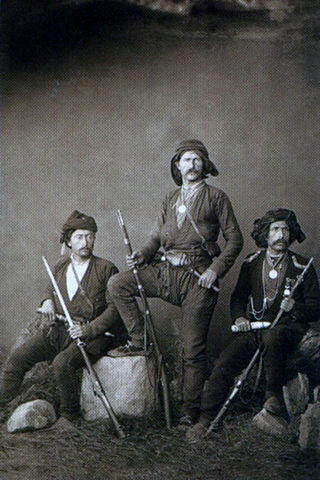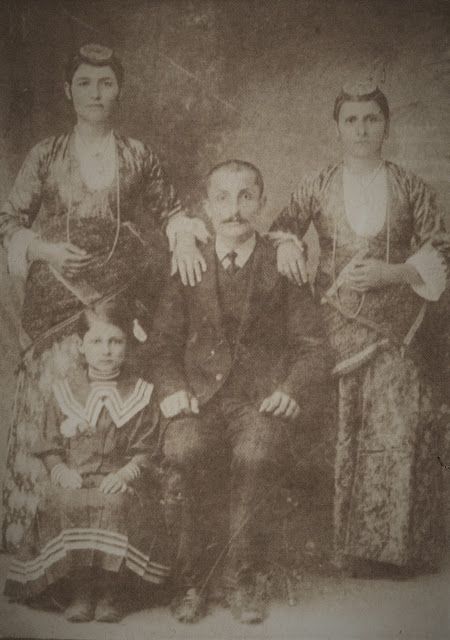Over the kamish and shalwar a kaftan was worn. This was made from a variety of rich materials in many colors. It fastened from the bottom of the front opening to about the waist, and the side seams were only sewn down to the waist. The three panels hung freely from there. The shalwar may have ornament on the sides intended to show through the slit. It often had front panels that were very wide, with the addition of extra panels along the lower part of the front opening. This was called Antari by the Armenians, and Zipouna by the Greeks. Here are two examples. The first is Armenian, the second Greek.
The Armenian anteri sometimes had extra long sleeves, as Armenians did in other areas. These were slit and hung down from the wrist.
Here is an example of such a garment.
Greek examples tend to be somewhat more restrained, although they were also often slit at the wrist.
A short waist length jacket was often worn with this outfit. Usually in a rich dark color, it was unpatterned, with a wide band of gold trim around the edges. Or the front opening was trimmed in fur.
Armenians would sometimes add extra gold couching on the back, and perhaps the front as well, in typical Armenian motifs.
The kaftan was always belted in some way. Here is an exhibit from the History Museum of Armenia. Here we see the kamish is in a rich gold weave, the kaftan, on the other hand is a simple wine color with gold embroidery on the cuffs, and also a narrow band of embroidery around the other edges. The jacket has couching on the sides, and the kaftan is cinched with an elaborate gold belt.
An Armenian example.
A couple of Greek examples.
As with the kaftans, the zonar came in a wide variety of colors and patterns.
Aprons were not worn by young women in the city, but were part of the dress of older women and women who lived in the countryside. These were of two kinds. The fota was woven of two different colors in wide vertical stripes, in cotton or wool for everyday, in silk for dress.
Armenian examples.
And Greek examples.
The second type of apron is made of a solid color, and is called pestampal. For dress it had an edging of gold cord, and might have a small area of gold couching at the bottom edge. I have only found Greek examples of this, but it does resemble Armenian aprons from other regions.
Sam Topalidis clearly states that aprons were worn over the zonar. However, he also included this image in his article.
A small, circular pillbox hat was worn with this costume, usually over the forehead, were held on with straps behind the neck, and were decorated with gold embroidery, coins or a metal plate on top. The Greeks called this tapla, and the Armenians gdak. Coins often were hung from the front edge, but only in younger women. The Greek ones seem to have been smaller.
Kerchiefs were worn in cooler weather and by older women, often over the pillbox.
For colder weather a second kaftan, called libade, was worn over the first. This was made of warmer materials and was lined, and sometimes wadded.
This Armenian woman is wearing the overkaftan on top of the zonar and apron, and a fez instead of the pillbox.
Rich jewelry of many types were part of this costume as well.
The men switched to western suits early, but in the city, they previously wore their own version of shalwar and, if wealthy, robes.
This was replaced by a fashion for Laz dress, called zipkas, first by younger men, and then it spread to the rest. This is now worn by Greeks, Armenians and Turks from this region when performing. This is a more Caucasian style costume. This appealed to more active young men.
A couple images of Laz costume. The first is one of the few images I have of the old Laz outfit for women. The middle is more Anatolian style, and the zipkas is on the right.

These outfits are very often black, but may also be brown, blue or gray.
A few more images to finish. First some Armenian.
And more Greek.
Thank you for reading. I hope that you have found this to be interesting and informative. I hope that this will especially help the Armenian community which has sometimes incorrectly replicated this costume.
Roman K
email: rkozakand@aol.com
Source Material:
I have found many of these images online, but this article by Sam Topalidis I found to be especially informative:
https://pontosworld.com/index.php/history/sam-topalidis/736-traditional-pontic-greek-costumes
Anelka Grigoryan et al, 'Armenian Costume 18th - 19th centuries', Yerevan, 2014
This is the best recent publication I have found on Armenian costume, showing photos of actual museum pieces rather than sketches or imperfectly replicated outfits.
Emma Abrahamian et al, 'The Costumes of Armenian Women', Tehran, 1974
Christos Broufas et al, '40 Greek Costumes from the Dora Stratou Theatre Collection'. Athens
Maria Lada-Minotos et al, 'Greek Costumes - Collection of the National Historical Museum', Athens, 1993



























































































Trabzon was actually found in 6th century BC.
ReplyDelete